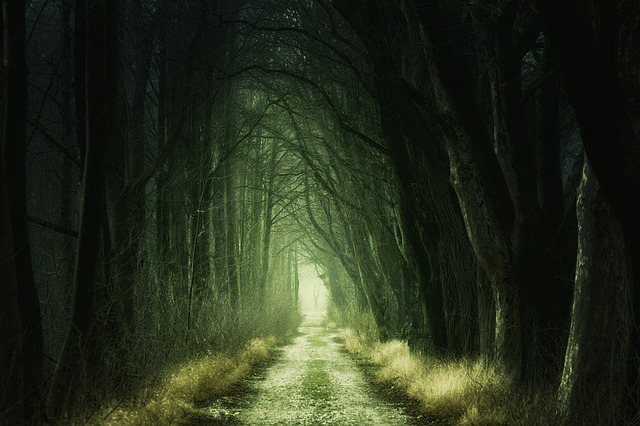Do you remember that heart-pounding moment when fear gripped you so tightly, your whole body seemed to freeze in place? It’s in those exhilarating seconds when we truly understand the power of being scared. Whether it’s the hair-raising feeling of walking alone in a dark forest or the bone-chilling sensation that something is lurking just out of sight, fear has a unique ability to captivate our senses. And as writers, harnessing that captivating emotion can bring a new level of intensity to our creative works. In this article, we will delve into the art of describing being scared in creative writing, exploring techniques that will send shivers down your readers’ spines and leave them hungering for more. So, buckle up and prepare to dive deep into the realm of heart-pounding moments.
Contents
- Why Describing Heart-Pounding Moments is Essential in Creative Writing
- The Power of Sensory Details: Paint a Vivid Picture
- Utilize Emotion-Driven Language to Evoke Fear in Readers
- Building Tension: Crafting Suspenseful Scenes
- The Art of Foreshadowing: Leave Clues for Readers to Unravel
- Crafting Authentic Characters: Understand Fear from Within
- Choose the Perfect Setting to Amplify Fearful Moments
- Experimenting with Pacing and Sentence Structure to Heighten Intensity
- Frequently Asked Questions
- Closing Remarks
Why Describing Heart-Pounding Moments is Essential in Creative Writing
One of the key elements in creative writing is the ability to captivate readers and evoke emotions through vivid descriptions. Describing heart-pounding moments in storytelling is essential as it allows readers to experience the exhilaration and intensity of the scene, creating a powerful connection between the reader and the narrative.
By vividly portraying heart-pounding moments, writers can engage their audience on a visceral level. The palpable sense of anticipation and adrenaline rush evokes a range of emotions, from excitement and fear to joy and relief. These moments of heightened tension and suspense grab the reader’s attention, holding it tightly and ensuring they remain engrossed in the story.
Without the inclusion of heart-pounding moments, creative writing runs the risk of becoming dull and uninteresting. These moments act as accelerators, propelling the story forward and adding a dynamic element to the narrative. They inject excitement, keeping the reader eagerly turning the pages, hungry to discover what happens next.
Furthermore, by effectively describing heart-pounding moments, writers can convey the protagonist’s emotions and enhance character development. The reader witnesses the character’s bravery, vulnerability, or determination, making them more relatable and enabling a deeper connection. Through these moments, the reader becomes emotionally invested in the story, allowing them to experience the rollercoaster of emotions alongside the characters.
The Power of Sensory Details: Paint a Vivid Picture
When it comes to writing, the use of sensory details holds immense power in captivating readers and bringing your words to life. By incorporating vivid descriptions that appeal to the five senses, you can transport your audience into the world you’ve created, immersing them in a rich and unforgettable experience.
How can you effectively utilize sensory details to enhance your writing? Here are some tips to get you started:
- Engage all the senses: Don’t limit yourself to just sight. Describe sounds, smells, tastes, and textures to create a fully immersive experience.
- Choose precise words: Select descriptive adjectives and adverbs that precisely convey the sensations you want your readers to feel.
- Create mental images: Use metaphors and similes to make abstract concepts more tangible and relatable.
- Appeal to emotions: Sensory details can evoke powerful emotions, so leverage this to connect with your readers on a deeper level.
By skillfully crafting your writing with sensory details, you can create a vivid tapestry that resonates with your audience long after they’ve finished reading. So, next time you sit down to write, embrace the power of sensory descriptions to truly paint a picture that will transport your readers to another world!
Utilize Emotion-Driven Language to Evoke Fear in Readers
Creating a Chilling Experience through Emotion-Driven Language
When it comes to captivating readers and immersing them in a gripping narrative, harnessing the power of emotion-driven language can send shivers down their spines. By skillfully crafting words that invoke fear, you have the ability to trigger a visceral reaction that will keep readers hooked until the very end. Here are some powerful techniques to utilize in your writing to evoke fear:
- Paint vivid and unsettling descriptions: Transport your readers into the heart of darkness by using rich, sensory language to detail the eerie atmosphere, chilling sights, and spine-tingling sounds that surround your characters. This will engross your readers and make them feel like active participants in the unfolding horror.
- Tap into primal fears: To truly make readers shudder, appeal to their deepest fears and insecurities. Whether it’s fear of the unknown, loss, or personal vulnerability, identifying and leveraging these primal terrors will intensify the emotional impact of your storytelling.
- Employ suspenseful pacing: Master the art of withholding and revealing information at precisely the right moments to create an air of palpable tension and keep readers on the edge of their seats. Gradually building suspense and releasing it in spine-chilling increments will maximize the fear factor and heighten their sense of anticipation.
To master the craft of evoking fear, it is crucial to infuse your writing with emotion-driven language that lingers long after the final page is turned. By skillfully utilizing these techniques, your readers will experience a thrill that will stay with them, leaving them hungry for more bone-chilling tales.
Building Tension: Crafting Suspenseful Scenes
Welcome to the world of crafting suspenseful scenes! In this post, we will delve into the art of building tension in your writing to create captivating narratives that keep readers on the edge of their seats. Whether you’re a novelist, screenwriter, or simply looking to add suspense to your short stories, mastering the art of building tension is a skill that will greatly enhance your storytelling ability.
To begin, let’s explore some techniques that can effectively heighten suspense in your scenes:
- Keep your readers guessing: One key element of building tension is to create uncertainty. By withholding information or introducing unexpected twists, you can ignite curiosity and keep your readers engaged. Leave breadcrumbs of clues throughout the scene, but keep the ultimate outcome shrouded in mystery.
- Employ the power of pacing: Varying the pace of your scene can greatly enhance tension. Slow, deliberate moments can build anticipation, while sudden bursts of action can jolt readers. Experiment with sentence length, dialogue, and descriptive details to maintain a balance between action and stillness, causing the tension to ebb and flow rhythmically.
- Create a sense of impending doom: Foreshadowing is a powerful tool to subtly hint at future conflicts or dangers. It plants seeds of unease in the minds of readers, ensuring that tension simmers beneath the surface. Skillfully weave in foreshadowing elements, whether through cryptic dialogue or symbolic objects, to create an atmosphere of impending doom.
By incorporating these techniques into your writing, you will be well on your way to crafting suspenseful scenes that have readers eagerly turning the pages. Remember, building tension requires a delicate balance and a keen understanding of pacing. Practice and experimentation will hone your skills, allowing you to masterfully hold your audience captive with every twist and turn of your storytelling.
The Art of Foreshadowing: Leave Clues for Readers to Unravel
Foreshadowing is a powerful storytelling device that adds depth, suspense, and intrigue to a narrative. By subtly hinting at events or outcomes to come, authors engage readers in a captivating guessing game that keeps them hooked until the very end. Whether you’re a writer looking to enhance your storytelling skills or a reader fascinated by the inner workings of literature, understanding the art of foreshadowing can greatly enrich your reading experience. Here are some key points to consider:
- Plant seeds of anticipation: Foreshadowing effectively plants seeds of anticipation in the minds of readers. By dropping subtle hints and clues throughout a story, the author creates an air of expectation, making readers curious and eager to uncover what lies ahead. These clues can take many forms, such as mysterious symbols, recurring motifs, or even subtle changes in a character’s behavior.
- Establish a sense of inevitability: Foreshadowing can create a sense of inevitability, where readers feel that certain events are bound to happen. This can heighten tension and keep readers on the edge of their seats, eagerly waiting for the predicted events to unfold. The art lies in striking a delicate balance – dropping enough clues to make the eventual outcome plausible, yet not revealing it so explicitly that readers lose interest in solving the puzzle.
The art of foreshadowing lies in its delicate subtlety and the excitement it generates within readers. By skillfully leaving clues for readers to unravel, writers create an interactive experience that makes the story come alive. These breadcrumbs of anticipation, when sprinkled throughout a narrative, have the power to captivate and engage readers, leaving them with a sense of satisfaction and fulfillment when they finally connect the dots. So, next time you embark on a literary journey, keep an eye out for those cleverly placed clues, as they may just lead you to the heart of the story.
Crafting Authentic Characters: Understand Fear from Within
When it comes to developing truly authentic characters in your writing, understanding fear is an essential ingredient. Fear is a powerful emotion that can shape a character’s actions, thoughts, and motivations, adding depth and complexity to their personality. By delving into the depths of fear from within, you can create characters that resonate with readers on a deep and emotional level.
Explore the following aspects to better comprehend fear and infuse it into your characters:
- Root causes: Every character has unique experiences that give rise to specific fears. Dive deep into their backstories to uncover the roots of their fears. It could stem from a traumatic childhood event, a personal failure, or even an irrational phobia.
- Physical manifestations: Fear doesn’t just exist in the mind – it manifests physically too. Consider how fear affects your character’s body. Do they tremble, sweat profusely, or have difficulty breathing? Including these physical cues in your writing will bring your characters to life.
- Internal monologue: Fear often triggers an internal dialogue within a character’s mind. Craft their thoughts in a way that reveals their fears and uncertainties. By exploring their inner voice, you can transport readers into the mind of your character and ensure a more immersive reading experience.
Choose the Perfect Setting to Amplify Fearful Moments
When it comes to creating an unforgettable experience, the setting plays a crucial role in intensifying fearful moments. From eerie haunted houses to creepy abandoned hospitals, there are numerous spine-chilling settings to choose from that will leave your heart racing and your imagination running wild. Here are a few spine-tingling settings that are guaranteed to amplify your fearful moments:
1. The Dark and Mysterious Forest
Venture into the depths of a dense, ominous forest cloaked in chilling shadows. Each rustle of leaves, the hooting of distant owls, and the murmur of unseen creatures will send shivers down your spine. With eerie whispering winds echoing through the mysterious trees, you’ll never know what lurks behind every corner. Let your imagination run wild as you navigate through an environment that plays tricks with your mind.
2. The Abandoned Asylum
Step into the world of madness and despair as you explore an abandoned asylum. The crumbling walls and decaying rooms create an atmosphere of eerie abandonment and haunted memories. Feel the weight of the past as you walk down the long, dimly lit hallways, hearing the faint echo of forgotten voices. Your heart will race as you discover the remnants of forgotten treatments, old operating rooms, and ghostly patient records. This setting will amplify your fearful moments and leave you questioning what truly happened within those haunted walls.
Experimenting with Pacing and Sentence Structure to Heighten Intensity
In the realm of storytelling, pacing and sentence structure play a pivotal role in creating intensity and capturing the attention of readers. By experimenting with these elements, writers can effectively mold the atmosphere, build tension, and deliver a gripping experience. Let’s explore some techniques that can be employed to heighten intensity in your narrative:
1. Varying Sentence Lengths: Mixing long and intricate sentences with short, punchy ones can create a sense of urgency. The sudden shift in pace can evoke a feeling of unease and keep readers on the edge of their seats. Additionally, longer sentences can be used to provide detailed descriptions, while shorter sentences can deliver swift action or impactful statements.
2. Strategic Placement of Punctuation: The careful use of punctuation, such as dashes, ellipses, and exclamation marks, can enhance the intensity of a scene. A well-placed dash can indicate a sudden interruption or change in direction, while the omission of full stops through the use of ellipses can create a suspenseful pause. However, it’s important to exercise restraint and not overuse these devices, as it can lead to a disjointed reading experience.
Frequently Asked Questions
Q: Why is it important to convey fear in creative writing?
A: Conveying fear in creative writing allows readers to experience intense emotions, making the story more engaging and memorable. It adds depth to characters, creates suspense, and evokes empathy from the audience.
Q: How can we effectively describe fear in writing?
A: Effective descriptions of fear in writing involve vivid language and sensory details, such as trembling hands, a racing heart, or a cold sweat. By using precise words and crafting realistic reactions, writers can make readers truly feel the characters’ fear.
Q: What are some techniques for building suspense in scary storytelling?
A: Utilizing techniques like foreshadowing, cliffhangers, and unpredictable plot twists can effectively build suspense. Gradually revealing information while maintaining an element of mystery will keep readers on the edge of their seats, heightening the fear factor.
Q: How can writers evoke fear through setting and atmosphere?
A: Writers can create a fearful environment by carefully choosing the setting and establishing a foreboding atmosphere. Descriptions of eerie landscapes, dimly lit rooms, or haunting sounds in the distance can enhance the reader’s sense of fear and unease.
Q: How can dialogue be used to convey fear?
A: Dialogue can convey fear through realistic, trembling voices, stammering, or using short, breathless sentences. Characters expressing their deepest fears and anxieties in conversation can increase tension and make the reader share in their emotions.
Q: Is it important to balance fear with other emotions in writing?
A: Yes, it is crucial to strike a balance. While fear is an essential element, incorporating other emotions like relief, hope, or determination adds complexity and makes the story more relatable. This mix of emotions resonates with readers on a deeper level.
Q: How can a writer effectively show a character’s fear without explicitly stating it?
A: Instead of outright stating fear, writers can show it through physical cues like trembling, sweating, or a character’s inability to speak. Internal monologues or their actions – like avoiding a dark room or suspicious behavior – can also indicate fear without directly mentioning it.
Q: How can writers make sure their descriptions of fear connect with readers?
A: To connect with readers, writers should use relatable experiences or fears that resonate with a wide audience. Utilizing universal fears like the fear of the dark, spiders, or the unknown can help readers personally relate to the characters and their emotions.
Q: How can authors use pacing to intensify fear in their stories?
A: Varying the pace of the narrative, particularly during suspenseful moments, can heighten fear. Quickening the pace during a heart-pounding scene and slowing it down during moments of anticipation can evoke a sense of urgency, making the reader’s heart race alongside the characters.
Q: Are there any common pitfalls in describing fear that writers should avoid?
A: Writers should avoid relying solely on clichés or overused phrases when describing fear. Instead, they should strive for originality and use unique descriptions. Additionally, it is important to use fear in a way that serves the story and characters, rather than just for shock value.
Closing Remarks
In conclusion, mastering the art of describing fear in creative writing can truly elevate the reader’s experience. By employing vivid sensory details and emotional connections, writers can captivate their audience and make heart-pounding moments truly come alive on the page.







